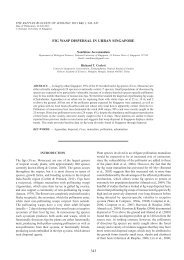1O257LF
1O257LF
1O257LF
Create successful ePaper yourself
Turn your PDF publications into a flip-book with our unique Google optimized e-Paper software.
© 2010 Dinosauria International Ten Sleep Report Series No. 1<br />
sometimes fused. These hypertrophic vertebrae (Fig 12 &<br />
33) may have helped in the same way that the handle of a<br />
long-range flail weapon helps to transmit power and speed<br />
through the unique combination of rigidity and looseness<br />
in the action of the tail. Much the same way a man would<br />
control a Three Section Staff during a strike.<br />
Toward the end of the DQ-TY tail, after the 32nd<br />
caudal or so, the neural spines suddenly change into<br />
simple but robust freestanding processes with a distinctive<br />
backward hook. These spines are without zygopophyses,<br />
and seem to have developed density to add both weight and<br />
strength to better control the free action in the tail. The major<br />
feature here is the densely weighted bone (synapomorphy),<br />
which would not be ideal as a bullwhip-like structure, but<br />
rather, supports the striking power of the tail. The hooked<br />
shaped neural spines may have helped to create a serrated<br />
edge along the tail, enhancing the flesh cutting ability<br />
of the tail during its use. Discoveries at Howe Quarry<br />
(Czerkas 1992, Ayer 2000, Michelis 2004) that preserved skin<br />
impressions from a tail section belonging to a diplodocid,<br />
clearly show that dermal spines were present, which may<br />
have been supported internally by these dense bone neural<br />
spines. In life, the whiplash vertebrae are spaced apart<br />
more than normal indicating that a tough flexible tissue<br />
may have held these elongated elements together. The<br />
presence of an abnormal amount of tissue between these<br />
elements is demonstrated by the evidence observed in the<br />
in situ discovery belonging to DQ-TY (Fig 12 F) . Past the<br />
40th vertebra or so, the supernumerary caudal elements<br />
become subequal in length developing biconvex ends in<br />
mature adults. In the immature specimen (DQ-TY) the ends<br />
of these caudal elements are nearly flat. The convexity is an<br />
ontogenetic feature in adults.<br />
Thus, the extraordinary functional morphology in<br />
the tail region of these dinosaurs supports the presence of<br />
a capability more sophisticated than the side swiping tail<br />
defensive behavior of a monitor lizard or crocodile. The<br />
extreme length of the tail may have allowed strikes to be<br />
made at targets in a wide radius possibly including in front<br />
of the animal. In life, Amphicoelias “brontodiplodocus” had a<br />
tail designed to slash flesh and strike with bone crushing<br />
power, with the added capability to hit a target with deadly<br />
accuracy.<br />
Fused Caudals<br />
Fused or coossified vertebrae are a characteristic<br />
Amphicoelias trait, but it is not found in all specimens where<br />
the tail is complete enough to be sure of its presence. This<br />
caudal vertebral fusion shows various degrees of ossification<br />
in individual specimens. It is always restricted to the section<br />
of vertebrae that are hypertrophic in development which are<br />
42<br />
Fig 30 Comparison of hind limbs in adults belonging to Diplodocus<br />
and Apatosaurus (Osborn 1899). Except for size and robustness,<br />
these elements are virtually the same.<br />
before the whiplash section. The centra in fused vertebrae<br />
display a scarred surface with extra bone growth that<br />
forms horizontal rod-like ridges. These may be identified as<br />
ossified longitudinal ligaments, possibly to create additional<br />
tail reinforcement. Interestingly, the same type of condition<br />
exists in living anteaters of South America, which also use<br />
their prehensile tails as a part of tripod rearing.<br />
DQ-SB shows no fusion of mid caudal vertebrae<br />
as seen in DQ-TY and DQ-BS. The loss of the tail vertebrae<br />
in life is perhaps a common feature in diplodocids and<br />
connected in some way to the absence of mid caudal fusion.<br />
The specimens which are lacking mid caudal fusion are not<br />
complete with whiptail sections and may support this notion<br />
(see list of specimens in Rothschild and Berman 1991). For<br />
example, AMNH 223 is not a complete tail section and lacks<br />
fusion of caudal vertebrae (Fig 29) . Fusion occurs in single<br />
or separate locations along the mid caudals in the specimens<br />
preserving relatively complete tail series, thereby, suggesting<br />
that the feature is not inherited but individually developed.<br />
A dual function may include the strengthening of an<br />
area on which to rest body weight during tripod standing<br />
as explained below. Examination of a series of kangaroo tail<br />
skeletons would be an interesting study to establish if there is<br />
a connection to caudal reinforcement as seen in Amphicoelias.<br />
In DQ-TY these caudals show what may be the earliest<br />
stages of ossification of longitudinal ligaments, a condition<br />
known only in the tail vertebrae of USNM 10865 and type<br />
of D. carnegii. This provides some evidence questioning the<br />
conclusions reached by the Rothschild and Berman (1991)<br />
study. Their study concluded that the fusion was the result



